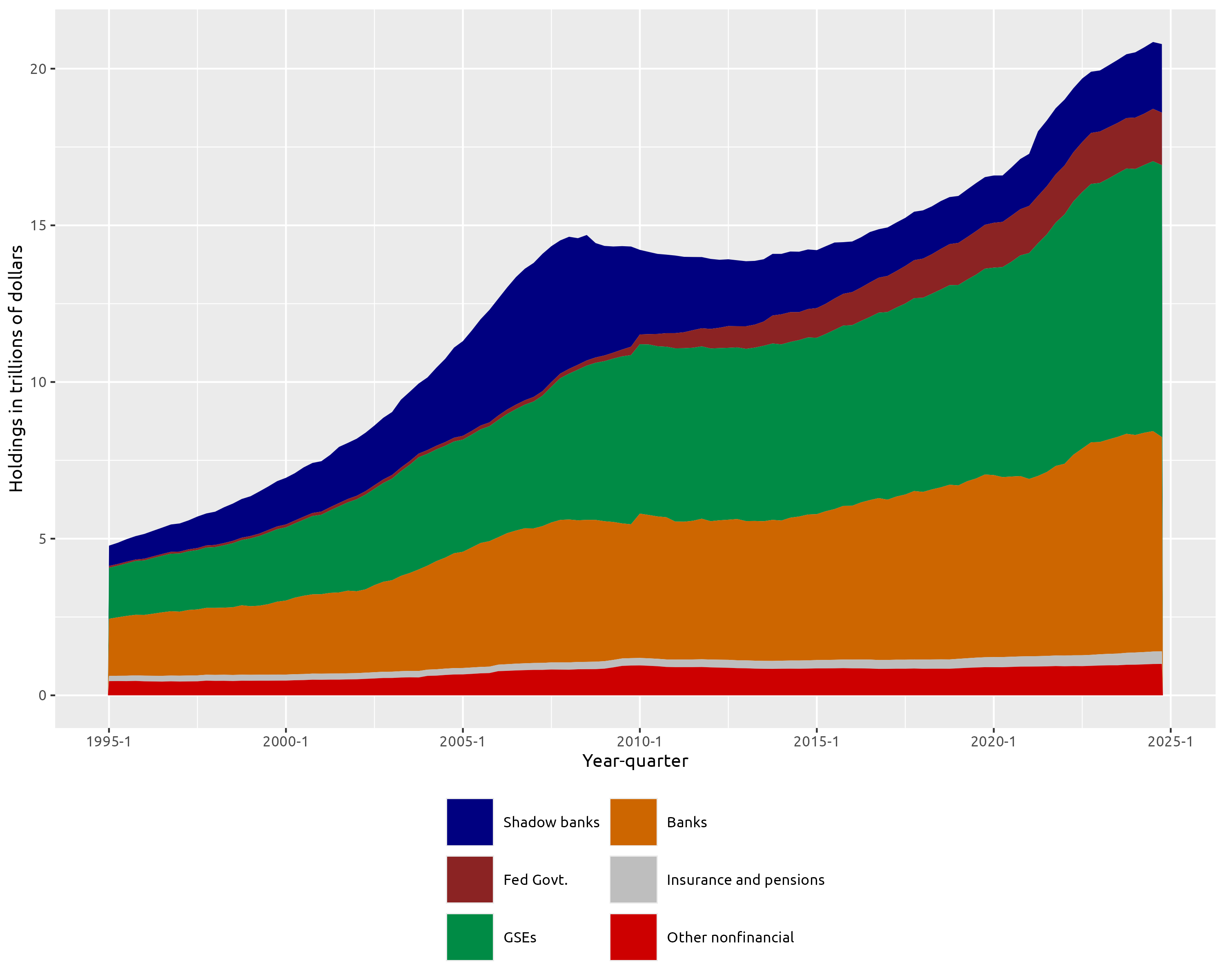Issuer-to-Holder (From-Whom-to-Whom)
Issuer-to-Holder (From-Whom-to-Whom) Data
Data
FWTW: CSV | Data Dictionary | Template Files
Description
The Financial Accounts of the United States (the Accounts) provides data on the financial assets and liabilities of the United States, disaggregated by sector and financial instrument. The Accounts can thus serve many purposes, such as sizing sectors and instruments, analyzing changes in credit flows, and assessing the net worth of households. However, they are not designed to reveal and analyze the linkages between sectors that provide and utilize funding - which we call “From-Whom-to-Whom” (FWTW) relationships. The FWTW relationships estimated in this project can be useful for studying how financial shocks could propagate throughout the economy or assessing cross-sector exposures via a given financial instrument. For example, as shown in the chart below, FWTW data can provide insight into how much of the growth in household debt prior to the financial crisis of 2007-2009 occurred outside of the traditional banking sector.
Holders of Household and Nonprofit Organizations Liabilities

The FWTW data cover each instrument in the Accounts, aggregated to the appropriate issuer, holder, and instrument totals in the Accounts, and are updated with each Z.1 release. The FWTW estimates are based upon a combination of detail underlying the Accounts, outside knowledge of market structure, and proportionality assumptions. We welcome feedback as we continually seek to improve our data and methods. Currently, the FWTW release includes only levels data; FWTW estimates for transactions, revaluations, and other volume changes are under development.
Documentation
See the Related FEDS note “Issuer-to-Holder (From Whom to Whom) Relationships in the Financial Accounts of the United States: A New Methodology and Some Early Results” for a full description of the data construction. In short, FWTW relationships for a given instrument begin with underlying Accounts detail where both the issuer and holder are identified, and then the remaining issuance for that instrument is split proportionally across holders, excluding sector pairs where outside knowledge of market structure indicates FWTW relationships are not material. The note includes an example of the algorithm that produces the results. The “Template Files” available above show the current inputs to the algorithm for each instrument (on the tabs labeled by 5-digit instrument code). The “About” tab describes the syntax of each numbered tab. The “Instrument” tab provides the instrument name associated with each 5-digit code. The “Sector List” tab provides the sector name associated with each 2-digit sector code. The FWTW data are available from the “CSV” hyperlink above. Each row is identified by the combination of holding sector, issuing sector, instrument type, and date (from 1945Q4 through the current Z.1 release). The “Data Dictionary” provides further details about each field.
Technical Note
Levels are occasionally negative in the FWTW data, usually because the relevant total issuance or total holdings in the Financial Accounts is negative. This most often occurs when the Financial Accounts total is reported on a net rather than gross basis. That is, the source data for a sector cannot disentangle issuance and holdings, and only the difference can be shown as either an asset or a liability. In these cases, negative FWTW levels can be interpreted as if the “from” and the “to” are reversed. In rare cases, Financial Accounts totals are negative due to data errors. Finally, the FWTW methodology will generate negative levels when the “known relationships” for a sector are larger than the total issuance or holdings for that sector, leaving a negative remainder to be spread across the other sectors. These imperfections in the FWTW methodology typically produce negative values that are near zero and occur decades ago. Still, we continue to monitor these situations and hope to eliminate them over time.